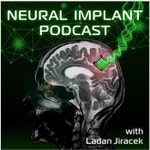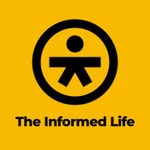Neural Implant podcast - the people behind Brain-Machine Interface revolutions – Détails, épisodes et analyse
Détails du podcast
Informations techniques et générales issues du flux RSS du podcast.

Neural Implant podcast - the people behind Brain-Machine Interface revolutions
Ladan Jiracek
Fréquence : 1 épisode/12j. Total Éps: 248

Classements récents
Dernières positions dans les classements Apple Podcasts et Spotify.
Apple Podcasts
🇫🇷 France - medicine
04/02/2025#76🇫🇷 France - medicine
03/02/2025#55🇫🇷 France - medicine
07/12/2024#90🇫🇷 France - medicine
06/12/2024#71🇫🇷 France - medicine
05/12/2024#41
Spotify
Aucun classement récent disponible
Liens partagés entre épisodes et podcasts
Liens présents dans les descriptions d'épisodes et autres podcasts les utilisant également.
See all- https://www.projectmedtech.com/
174 partages
- https://feedly.com/
76 partages
- https://www.linkedin.com/in/duanemancini/
171 partages
Qualité et score du flux RSS
Évaluation technique de la qualité et de la structure du flux RSS.
See allScore global : 32%
Historique des publications
Répartition mensuelle des publications d'épisodes au fil des années.
Exploring the Miami Project to Cure Paralysis with David McMillan
lundi 14 octobre 2024 • Durée 29:26
In this episode of the Neural Implant Podcast, host Ladan speaks with David McMillan, the Director of Education Outreach for the Miami Project and a Research Assistant Professor in the Department of Neurological Surgery at the University of Miami. They discuss the Miami Project's work, particularly in spinal cord injury research and neuroprosthetics. Topics include clinical trials, combining therapies, regulatory challenges, and the importance of rehabilitation in conjunction with therapeutic technologies.
00:00 Introduction to the Neural Implant Podcast 00:16 Meet David McMillan: Director of Education Outreach 01:07 The Miami Project to Cure Paralysis 03:36 Clinical Trials and Patient Recruitment 08:01 Innovative Neurostimulation Projects 20:54 Challenges and Future of Neuromodulation 24:17 Role of Director of Education and Outreach 28:21 Final Thoughts and ConclusionExploring Contract Engineering in Neurotechnology with Javier Schandy and Nicolas Barabino
lundi 7 octobre 2024 • Durée 28:31
I n this episode of the Neural Implant Podcast, host Ladan welcomes Javier Schandy and Nicolas Barabino from Focus, an engineering services company based in Uruguay. They discuss their work in firmware, hardware, and software development for medical devices, emphasizing their specialization in wireless communications and test automation.
They also explain the benefits of contract engineering, the challenges they face, and highlight an exciting project involving an injectable neurostimulator. The conversation covers the history of neurotechnology development in Uruguay, the process and dynamics of working with clients, and the adaptability and innovative spirit of their company.
00:00 Introduction to the Neural Implant Podcast 00:18 Meet the Guests: Javier Shandy and Nicholas Barabino 01:05 Focus: Engineering Services in Medical Devices 02:58 Project Onboarding and Development Process 06:06 Specialties and Expertise in Neurotechnology 09:38 The Journey into Medical Devices 13:41 Uruguay's Legacy in Medical Devices 20:37 Challenges and Advice for Startups 23:05 Flexible Project Management and Cost Considerations 27:51 Conclusion and Final ThoughtsGene Fridman on his freeform stimulator allowing for more neural stimulation possibilities
lundi 9 octobre 2023 • Durée 33:24
Dr. Gene Fridman is an Associate Professor in the Department of Otolaryngology Head and Neck Surgery and also has appointments with the Department of Biomedical Engineering and the Department of Electrical and Computer Engineering. His research is in the areas of bioinstrumentation and neural engineering.
In this episode we talk about his freeform nerual stimulator which allows for DC and any other waveforms without any electrolytic effects on the electrodes. This opens up many possibilities for neural stimulation. We also talk about his startup Aidar which is like a 'tricorder' all-in-one medical diagnostic tool.
This podcast is sponsored by CEITEC Nano, check out their Neurotech Device Manufacturing Capabilities here
Top 3 Takeaways:
-
"The reason why they have to use pulses at the metal electrodes is that if you deliver electrical current for too long to a metal electrode that is implanted in the body, what you're going to get is you're going to get electrochemistry, the first thing that will happen is you're going to start forming bubbles because you're going to split water. It's electrolysis. So you clearly don't want to do that in the body. They have to use pulses charge balanced by phasic pulses otherwise, you're going to have these electrons jump across and cause chemical reactions"
-
"By introducing hyperpolarizing current to the peripheral nerve what we're seeing is it's affecting the small caliber neurons much more so, which carry pain much more so than the larger neurons that carry other information. And so we're able to block pain at the peripheral nerve. We didn't know about this. It was a surprise to us."
0:45 "Do you want to introduce yourself better than I just did?"
3:00 Do you want to talk about your device able to talk to both ions and electrons in neurotech?
7:00 Was a DC bridge rectifier the inspiration for this?
9:15 What is possible with these new waveforms?
15:15 "How big is it? And why does it need to be that size?"
21:45 CEITEC Nano Ad Sponsorship
22:15 Do you want to talk about your startup company, Aidar?
24:30 Are you doing any nerve stuff with the 'tricorder?'
26:30 How are you able to manage the time with the startup?
27:45 How did you get the project's initial data?
Lloyd Diamond Discusses How Pixium Vision is Creating a Solution for Dry Age-Related Macular Degeneration
lundi 2 novembre 2020 • Durée 29:14
Lloyd Diamond is the CEO of Pixium Vision. Dry age-related macular degeneration affects millions of people globally. Using an insertable implant in the eye in combination with lenses, central vision focus can be regained. In this episode, Lloyd Diamond discusses how Pixium Vision is creating a solution to dry age-related macular degeneration.
Top three takeaways:
- There is a dry and wet form of age-related macular degeneration. The dry form makes up 80% of all cases.
- The degeneration begins in the center of the eye and then migrates to the periphery at the age of 60-65.
- The implant is no thicker than a human hair and contains 378 independent electrodes on it, activated by light.
[0:00] Ladan introduces the episode and the guest, Lloyd Diamond.
[1:50] Diamond explains the need for a device like the PRIMA system.
[4:00] The macular degeneration (AMD) targets the central vision portion of the retina, making it difficult to read or recognize faces.
[7:00] The retinal surgery recovery time is four weeks. After this, the activation and rehabilitation process begins.
[9:30] A pair of lenses that houses a camera are used in combination with the implant.
[11:45] The entire event of observance to signal processing occurs in microseconds, so the user is unaware of the reaction time of the device.
[16:00] Their new data proves that using clear glasses and the implant, it is possible to read as small as size eight font. This demonstrates seven lines of improvement on an ETDRS chart.
[19:00] Diamond discusses the history of Pixium.
[21:30] Due to the difficulty in regulatory approval for these types of implants, AMD research is not as common as retinitis pigmentosa.
[25:00] The ability to be independent and recognize family members’ faces makes the rehabilitation time and procedure appealing to the aged population.
[27:20] The future goal is to sell in Europe first and then bring devices to the US using FDA approval.
Renee Ryan and Dr. Kate Rosenbluth Discuss How the Cala Trio Controls Tremors
lundi 26 octobre 2020 • Durée 26:52
Renee Ryan is the CEO and Dr. Kate Roosenbluth is the founder, CSO, and member of the board of directors for Cala Health. The company creates bioelectronic neuromodulation devices to mitigate the effects of chronic diseases. In this episode, Renee Ryan and Dr. Kate Rosenbluth discuss how the Cala Trio device controls essential tremors.
Top three takeaways:
- The Cala Trio device uses the nerve circuitry of the body to calm tremors by stimulating a part of the brain through the wrist.
- Accelerometer sensors in each of the devices assess the efficacy of each use.
- There is a digital screen on the watch that displays time, length of session, and tasks.
[0:00] Ladan introduces the episode and the guests, Renee Ryan and Dr. Kate Rosenbluth.
[4:50] Dr. Kate Rosenbluth explains the history of the company and its goals.
[7:00] The wearable device goes on the user’s wrist to stimulate the ventral intermediate nucleus in the brain.
[9:00] The essential tremors are characterized by action tremors in the hands, which makes daily tasks incredibly difficult.
[13:40] Cala Health plans to accomplish more wrist-based projects to help mitigate other chronic diseases.
[16:30] Renee Ryan explains her transition from investor to CEO at Cala Health.
[19:30] The demand for the Cala Trio device was so great that the clinical trials were fully enrolled within 6 weeks.
[22:30] Due to the wristband having dry electrodes, the band needs to be replaced every 90 days.
[25:20] A new device trial has started that includes a new band technology.
Iain McIntyre Discusses How the Humm Bioelectric Memory Patch Provides a Brain Boost
lundi 19 octobre 2020 • Durée 23:39
Iain McIntyre is the CEO and co-founder of Humm. Humm creates devices such as the Bioelectric Memory Patch that use electricity to stimulate the brain. The disposable forehead device has shown to cause an increase in brain functionality and memory.
In this episode, Iain McIntyre discusses how the Humm Bioelectric Memory Patch provides a brain-boost.
Top three takeaways:
- When this device improves your working memory, it is improving your capabilities to focus, multitask, and acquire new skills.
- The Humm Bioelectric Memory Patch brings neuromodulation to a cheaper and smaller design compared to traditional devices.
- The benefits of use compound over time; even in the beginning stages, 15 minutes of use could provide up to two hours of mental performance improvement.
[0:00] Ladan introduces the episode and the guest, Iain McIntyre.
[2:50] The Bioelectric Memory Patch device works by delivering tACS to stimulate the prefrontal cortex and improve working memory.
[5:00] The research studies done at Berkeley showed that users of the patch had a 20% increase in working memory effectiveness.
[8:20] McIntyre describes it as a compound interest transaction, the more the patch is used, the greater the benefits each time.
[11:10] Humm can provide results in a safe manner where there are rarely side effects due to the low amount of current.
[14:00] While trials and data collection currently assess healthy users; in the future, the project will be used to help with neurological diseases.
[17:00] Interestingly, the test groups that were found to have the most need for such a device are college students and the elderly.
[21:10] With a 15-minute session, you can achieve an hour and a half of noticeable brain activity improvement.
Dr. Sangeeta Chavan Discusses the Fourth Annual Bioelectronic Medicine Summit
lundi 12 octobre 2020 • Durée 17:25
Dr. Sangeeta Chavan is a professor at the Feinstein Institutes for Medical Research. In September of 2020, the Feinstein Institutes hosted its fourth annual Bioelectronic Medicine Summit located in New York. In this episode, Dr. Sangeeta Chavan discusses the key takeaways of the summit.
Top three takeaways:
- Bioelectronic medicine uses modulation and stimulation of neural activity for the benefit of those with diseases as an alternative to drugs.
- Various advances are being made in clinical trials dealing with problems such as Crohn’s disease, neural plasticity disorders, and vision loss.
- Vagus nerve stimulation has opened a gateway to many bioelectronic medicine applications.
[0:00] Ladan introduces the episode and the guest, Dr. Sangeeta Chavan.
[3:40] Dr. Chavan discusses Dr. Kevin Tracey’s background in neuromodulation.
[5:10] Bioelectronic medicine takes into account molecular mechanisms and neural circuits that contribute to diseases, to be able to modulate them.
[7:20] At the summit, Dr. Chris Puleo discussed non-invasive neuromodulation using ultrasound as a form of therapy.
[9:30] The speakers that inspired Dr. Chavan the most were Dr. Molly Stevens and Dr. Chris Collier for their cutting-edge projects.
[11:50] The keynote speaker for the second day was Dr. Lawrence Steinman, whose research focuses on the role of amyloid proteins in inflammatory disease models.
[13:40] Dr. Larry Miller spoke about the uses of bioelectronic medicine in regulating sphincter function.
[15:00] Targeting nerves to treat diseases has been proven to work for many patients and is continuing to grow.
To learn more about the Feinstein Institutes, listen to these episodes: Dr. Stavros Zanos, Dr. Kevin Tracey, Jojo Platt, Dr. Harbi Sohal
Dr. Owen Phillips Discusses How BrainKey Develops 3-D MRI Visualizations
lundi 5 octobre 2020 • Durée 15:15
Dr. Owen Phillips is the co-founder and CEO of Brainkey. Their mission is to “revolutionize brain health care by helping people access, understand, and benefit from advances in our understanding of the human brain”. Brainkey’s work allows patients to view their own MRI scans in 3-D while teaching them about the regions of the brain through an online platform. In this episode, Dr. Owen Phillips discusses how BrainKey develops 3-D MRI visualizations.
Top three takeaways:
- An MRI consists of photographic slices of your brain put together to produce an image. Brainkey takes these images and makes a 3-D model.
- 3-D imaging allows for biometric data to be collected that could provide more information about neurological diseases.
- Your brain age can be calculated through the MRI scans, giving patients data to track brain health.
[0:00] Ladan introduces the episode and the guest, Dr. Owen Phillips.
[2:30] Dr. Owen Phillips explains how Brainkey makes medical imaging friendly for the patient.
[4:00] By developing relationships with MRI centers, Brainkey can provide affordable MRI scans.
[6:20] Repeated Brainkey MRI scans can allow patients to view how their brain has changed over time and check on their brain health.
[8:30] As a HIPAA compliant company, they ensure that patient data is secure.
[10:20] Aside from getting a 3-D visualization, you can also get a life-size 3-D print of your brain.
[13:25] While many are still able to upload their MRI into Brainkey, COVID has made it difficult to provide MRI scans as easily.
Dr. Alfred Poor Discusses Current Events in Brain-Computer Interface Technology
lundi 28 septembre 2020 • Durée 31:36
Dr. Alfred Poor is the editor and publisher at Health Tech Insider. Aside from this, he is also a technology speaker and writer, providing insight into the health technology community. In this episode, Dr. Alfred Poor discusses current events in brain-computer interface technology.
Top three takeaways:
- Health Tech Insider provides newsletters that cover wearable mobile devices for health and medical applications.
- In this time of online conferences, it takes great lighting, audio, and engagement to be a successful speaker.
- It is becoming increasingly popular for doctors to remotely monitor patients.
[0:00] Ladan introduces the episode and the guest, Dr. Alfred Poor.
[2:20] Dr. Poor discusses the differences between online and onsite conferences.
[5:10] Dr. Poor emphasizes the importance of having an online conference structure that allows for audience participation.
[8:20] Using an external camera and microphone during online meetings can keep members engaged and help presenters get their message across clearly.
[11:40] After the COVID-19 pandemic, the new normal will include much more online events than previously.
[13:10] Dr. Poor describes his roles at Health Tech Insider.
[16:30] Brain-computer interface technology is creating ways to close a feedback loop for motion and senses in the body.
[18:10] Smartphone technology has accelerated the progress of brain-computer interface devices.
[21:35] Monitoring of blood sugar levels has become exponentially easier over time due to continuous glucose monitors and now under-the-skin sensors.
[25:00] Artificial intelligence and machine learning play key roles in making use of the biometric data collected with new technologies.
[28:30] A new Galaxy watch product will be able to take in blood pressure and ECG.
Jim Pearson, Dr. Julian Bailes, and Joseph Mark Discuss How Nico Neuro is Innovating Brain Surgery
lundi 21 septembre 2020 • Durée 33:49
This week’s guests from NICO Corporation are Jim Pearson, who is the founder, president, and CEO, and Joseph Mark, CTO. The third guest is Dr. Julian Bailes, part of the NorthShore University Health System as Co-Director of the NorthShore Neurological Institute. The NICO Corporation is based in Indianapolis. Their technology has been used in over 35,000 brain surgeries, published in 100+ clinical articles, and they have been awarded hundreds of patents on their technology and surgical methodologies. In this episode, Jim Pearson, Dr. Julian Bailes, and Joseph Mark discuss how NICO Corporation is innovating brain surgery.
Top three takeaways:
- The brain is the last and only major organ in the human body left to not have a Minimally Invasive approach. NICO is changing this through the use of their interventional technology coupled with advanced imaging. The brain’s fiber tracks can be identified, and these images are then coupled with NICO’s technology allowing imaging and intervention to be used simultaneously, resulting in more effective and safe brain surgeries.
- NICO Corporation has developed technologies and a brain surgery approach that displaces tissue using the natural folds to gain access rather than slicing through it and it has successfully been used over 35,000 brain surgeries.
- Their current technology has solved the demanding problem of internal safe access to deep areas in the brain to remove a tumor or a blood clot. Now, their next challenge is about “putting technology into the brain”. They are at the cutting edge of Brain-Computer Interface (BCI) and they are accomplishing this by being the first to implant a computer chip deep in the brain (not just on the surface) where 99% of the functioning of the brain occurs.
[0:00] Ladan introduces the episode and the guests, Jim Pearson, Joseph Mark, and Dr. Julian Bailes.
[3:35] Jim Pearson discusses the start of NICO Corporation.
[5:25] Dr. Julian Bailes tells of his experience as a neurosurgeon working with NICO Corporation.
[7:30] Joseph Mark describes the process of designing devices that provide safe access to the brain.
[10:00] The displacement method does not cut through tissue but rather moves it while keeping it intact.
[13:10] Other aspects such as tissue preservation and biological preservation are beginning to show importance in brain tumor research.
[16:20] Their next project is to implant a murine model in a rat to show that it is possible to get in and out of the deepest areas of the brain without compromising brain function. This is where 99% of the functionality is and the most important aspect of the brain.
[18:17] For human patients, the access portals are 11 and 13.5 millimeters in diameter; and these values are scaled down for animal implants.
[21:30] The future of NICO Corporation is finding ways to surgically place things into the brain causing the least damage and minimizing invasion.
[24:00] Their current focus is a major trial on hemorrhagic strokes, which Dr.Bailes is a part of.
[27:20] The group seeks to find what effect the mechanical interfaces have on the final results of the brain surgery.
[31:15] The NICO Corporation ensures that each customer of their devices is properly trained before use.









